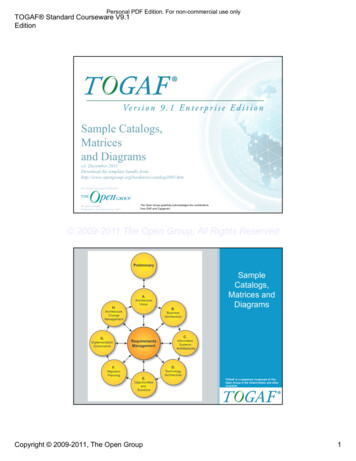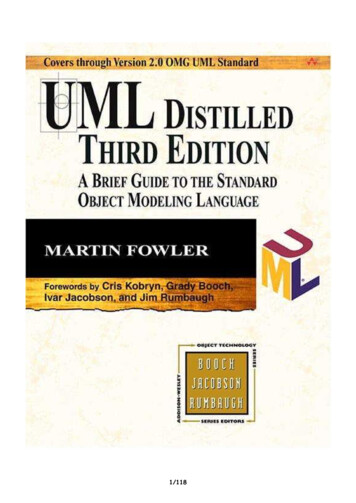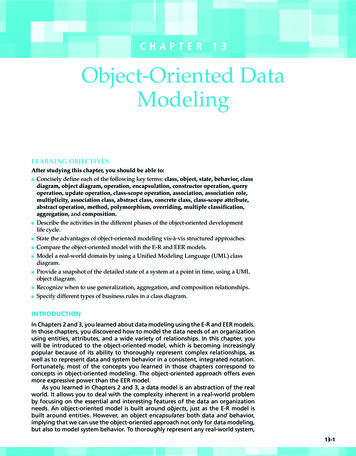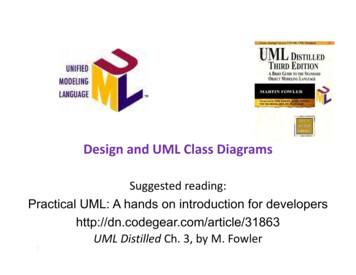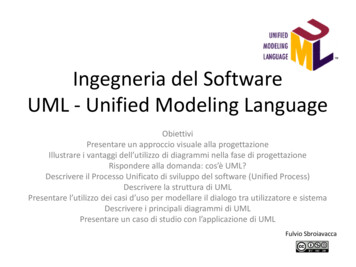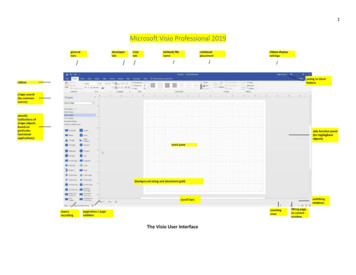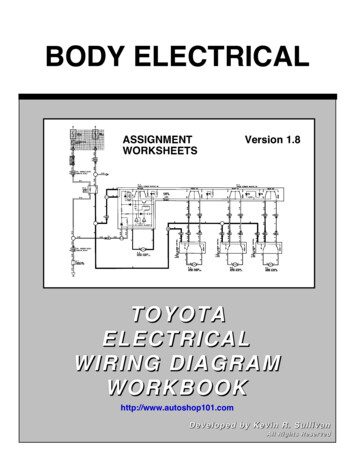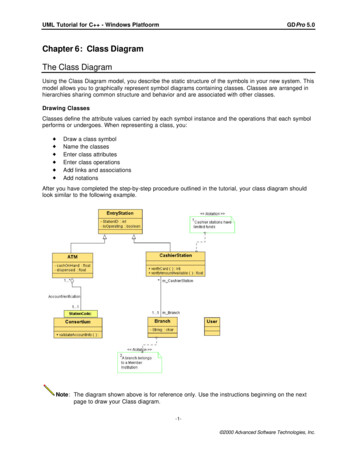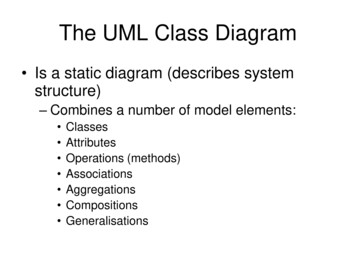
Transcription
The UML Class Diagram Is a static diagram (describes systemstructure)– Combines a number of model elements: ClassesAttributesOperations alisations
A UML ClassNameAttributesOperationsProperties of class diagrams:- Static model;- Models structure and behaviour;- Used as a basis for other diagrams;- Easily converted to an object diagram.
Determining Classes (1/2) Is there data that requires storage,transformation or analysis? Are there external systems interacting with theone in question? Are any class libraries or components being use(from manufacturers, other colleagues or pastprojects)? Does the system handle any devices? Does the system model organisationalstructures? Analyse all actor roles.
Determining Classes (2/2) Textual Analysis(based on Dennis, 2002) A common or improper noun implies a class A proper noun or direct reference implies an object (instance of aclass) A collective noun implies a class made up of groups of objects fromanother class An adjective implies an attribute A “doing” verb implies an operation A “being” verb implies a classification relationship between anobject and its class A “having” verb implies an aggregation or association relationship A transitive verb implies an operation An intransitive verb implies an exception A predicate or descriptive verb phrase implies an operation An adverb implies an attribute of a relationship or an operation
UML Class Attributes (1/2) Very system dependent Describe characteristics of objects belonging tothat class Can be informative - or confusing Has a definite type––––Primitive (Boolean, integer, real, enumerated, etc.)language specificother classesany user defined type Has different visibility, including:– public (viewed and used from other classes)– private (cannot be accessed from other classes)
UML Class Attributes (2/2) Can be given a default valueCan be given class-scopeCan list possible values of enumerationDirectly implementable into most modernprogramming languages with object-orientedsupport (e.g. Java)Attribute syntax:Visibility name:type init value{property string}
UML Class Attribute ExamplesUNIXaccount username : string groupname : string filesystem size : integer creation date : date- password : stringInvoiceUNIXaccount username : string groupname : string “staff" filesystem size : integer creation date : date- password : stringInvoice amount : real amount : real date : date current date date : date current date customer : string customer : string specification : string specification : string- administrator : string "unspecified"- administrator : string "unspecified" - number of invoices : integer- number of invoices : integer status : status unpaid { unpaid, paid }
UML Class-to-Java ExamplePublic class UNIXaccount{public string username;public string groupname "csai";public int filesystem size;public date creation date;private string password;static private integer no of accounts 0public UNIXaccount(){//Other initialisationno of accounts ;}//Methods go here};UNIXaccount username : string groupname : string “staff" filesystem size : integer creation date : date- password : string- no of accounts : integer 0
Operations (Methods)Public class FigureFigure{- x : integer 0private int x 0;- y : integer 0private int y 0; draw()public void draw(){//Java code for drawing figure}};Figure fig1 new Figure();Figure fig2 new Figure();fig1.draw();fig2.draw();
Constraints on OperationsPoliceStationalert (Alarm)1 station*BurglarAlarmisTripped: Boolean falsereport (){ if isTrippedthen station.alert(self)}
Association lianceRadio*CompanycarDriver1AdultDrives *EmployeeMarried toHusband1CarDrives Driver WifeCompanycarPerson ·Turns onMum· CleansFamilymemberToaster · TunesDad*ChildCar
Qualified and "Or" AssociationsPersonUserPIDItem ofclothing1Plates** *Host
Ordered and Ternary AssociationsLibrary1.**{ordered by date}Books1 .** {ordered by surname}MemberNo qualified or aggregationassociations allowed in ternary.0.* Credit cardBank card1.* Client1.* ShopPersonEstablishment
Another Ternary AssociationExampleYearseason Team goalkeeperteamRecordgoals forgoals againstwinslossestiesPlayer
Association ClassesHost*AdapterComputerNetwork ateContractPrint spooler1.*Printer
Association by Aggregation
Alternative Notation forComposition AssociationCarWheelsBodyEngineWiring****Note that associationmultiplicity is shownwithin the classes
Roles in AggregationMy familyMy familyFionaErnestZooErnest: Family memberFiona: Family memberFamilymemberZoo0.*0.* 1.*MammalFalcon0.*BirdCage1.*EquipmentMonkey[0.*]: MammalGiraffe[0.*]: MammalHuman[1.*]: MammalFalcon[0.*]: BirdCage[1.*]: Equipment
Abstract Classes
Abstract Classes andGeneralisation ExampleAircraft{abstract}MakeSeatsEngine typeStart() {abstract}land() {abstract}HelicopterJet planeMakeSeatsEngine typeMakeSeatsEngine typeStart()land()Start()land()Start jet enginesLower flaps& landing gearStart bladesDecreaseprop speed
Aggregation and GeneralisationConsists of*Figure{abstract}Position: PosConsists of*ElectronicCanvasDraw() {abstract}GroupPolygonLineConsists ofDraw()Draw()Circle*Draw()Draw()
Implementing it (e.g. in Java)abstract public class Figure{abstract public void Draw();Pos position;}public class Group extends Figure{private FigureVector consist of;public void Draw(){for (int i 0; i consist of.size(), i ){consist of[i].draw();}}}public class Polygon extends Figure{public void Draw(){/* something similar to grouponly using lines instead */}}public class Line extends Figure{public void Draw(){/* code to draw line */}}public class circle extends Figure{public void Draw(){/* code to draw circle */}}
Constrained Generalisations Overlapping A type of inheritance whereby sharing of commonsub-classes by other sub-classes is allowed. Disjoint (the default) The opposite of overlapping. Complete A type of inheritance whereby the existing subclasses are said to fully define a given super-class.No further sub-classing may be defined. Incomplete (the default) Further sub-classes can be added later on to moreconcretely specify a given super-class.
Overlapping ceiverAmplifierTV setMonitorunit
Complete lete}ManWoman
Expressing Rules in UML Rules are expressed using constraints andderivations Constraints were mentioned earlier (e.g. orassociations, ordered associations, inheritanceconstraints, etc.) Derivations are rules governing how entities canbe derived (e.g. age current date - DOB)
Example of Derived er craftAircraftIs on/1 class passengerPassenger/1 class tionTicket price/1 class passengerTurbo-propaircraftJet-turbineaircraft{1 class passenger (Ticket price 400)}N.B. Relation cardinality is omitted for example clarity
Another Example of a Date of registrationArea/Supermarket/bulk-buying customerCustomer{Supermarket (Area 200 && Category "dept")}N.B. Relation cardinality is omitted for example clarity
Example of a ConstraintAssociationDatabase{subset}Entry inMaintainsOrganisationProject manager ofMember ofEmployeeN.B. Relation cardinality is omitted for example clarity
Association Class
Class �ClassDClassC combinestwo logical classesClassE
Concrete Dependency access»
Class Diagram ExampleElement covalent CCarbonHydrogenC covalent CH
Instantiation of Class Diagram(in previous drogen:Hydrogen:Hydrogen
Another Class Diagram ExampleCreditCard{abstract}OrderBean{abstract} interface EntityBeanorder* getOrderStatus setOrderStatus getLineItems setLineItems getCreditApproved ctMyLineItem*
Try This Yourselves Create a class diagram to represent aarbitrary interconnection of computers Create a class diagram to represent a hierarchicaldirectory system in any OS
Determining Classes (2/2) Textual Analysis (based on Dennis, 2002) A common or improper noun implies a class A proper noun or direct reference implies an object (instance of a class) A collective noun implies a class made up of groups of objects from another class An adjective implies an attribute A "doing" verbimplies an operation A "being" verbimplies a .
